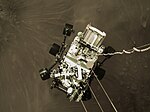astro.wikisort.org - Star
HD 108236 is a G-type main-sequence star. Its surface temperature is 5660±61 K. HD 108236 is severely depleted in heavy elements compared to the Sun, with a metallicity Fe/H index of −0.28±0.04 (52% of the Solar System), and is probably older than the Sun at 6.7+4.0
−5.1 billion years.[3]
| Observation data Epoch J2000 Equinox J2000 | |
|---|---|
| Constellation | Centaurus |
| Right ascension | 12h 26m 17.8916s[1] |
| Declination | −51° 21′ 46.2141″[1] |
| Apparent magnitude (V) | 9.24 |
| Characteristics | |
| Evolutionary stage | main-sequence star |
| Spectral type | G5V |
| Astrometry | |
| Radial velocity (Rv) | 16.78±0.22[2] km/s |
| Proper motion (μ) | RA: −70.627[2] mas/yr Dec.: −49.758[2] mas/yr |
| Parallax (π) | 15.4861 ± 0.0127 mas[2] |
| Distance | 210.6 ± 0.2 ly (64.57 ± 0.05 pc) |
| Details[3] | |
| Mass | 0.869+0.050 −0.048 M☉ |
| Radius | 0.877±0.008 R☉ |
| Luminosity | 0.708±0.047 L☉ |
| Surface gravity (log g) | 4.49±0.11 cgs |
| Temperature | 5660±61 K |
| Metallicity [Fe/H] | −0.28±0.04 dex |
| Age | 6.7+4.0 −5.1 Gyr |
| Other designations | |
| Database references | |
| SIMBAD | data |
According to WISE mission data, the star was suspected to be surrounded by a debris disk, but a reanalysis of the data rejected the debris disk hypothesis by 2014.[4] The reason for the false positive was contamination from a nearby infrared source.[5]
Planetary system

In 2020, four planets orbiting HD 108236 were discovered[6] by the transit method, followed by another one in 2021.[3]
| Companion (in order from star) |
Mass | Semimajor axis (AU) |
Orbital period (days) |
Eccentricity | Inclination | Radius |
|---|---|---|---|---|---|---|
| b | 4.2±1.2 M🜨 | 0.0451±0.0004 | 3.79523+0.00047 −0.00044 |
0 | 88.23±0.32° | 1.586±0.098 R🜨 |
| c | 9±2 M🜨 | 0.0626±0.0006 | 6.2037+0.00064 −0.00052 |
0 | 88.8±0.2° | 2.068+0.10 −0.091 R🜨 |
| d | 7.8+3.2 −1.8 M🜨 |
0.1087±0.0010 | 14.1756+0.001 −0.0011 |
0 | 88.8±0.1° | 2.72±0.11 R🜨 |
| e | 8.4+6.6 −1.4 M🜨 |
0.1348±0.0012 | 19.592±0.002 | 0 | 89.3±0.1° | 3.12+0.13 −0.12 R🜨 |
| f | 4+2 −1 M🜨 |
0.1773±0.0016 | 29.53935+0.00012 −0.00014 |
0 | 89.07±0.03° | 1.89±0.04 R🜨 |
References
- "HD 108236". SIMBAD. Centre de données astronomiques de Strasbourg. Retrieved 2021-01-17.
- Brown, A. G. A.; et al. (Gaia collaboration) (2021). "Gaia Early Data Release 3: Summary of the contents and survey properties". Astronomy & Astrophysics. 649: A1. arXiv:2012.01533. Bibcode:2021A&A...649A...1G. doi:10.1051/0004-6361/202039657. S2CID 227254300. (Erratum: doi:10.1051/0004-6361/202039657e). Gaia EDR3 record for this source at VizieR.
- Bonfanti, A.; Delrez, L.; Hooton, M. J.; Wilson, T. G.; Fossati, L.; Alibert, Y.; Hoyer, S.; Mustill, A. J.; Osborn, H. P.; Adibekyan, V.; Gandolfi, D.; Salmon, S.; Sousa, S. G.; Tuson, A.; Van Grootel, V.; Cabrera, J.; Nascimbeni, V.; Maxted, P. F. L.; Barros, S. C. C.; Billot, N.; Bonfils, X.; Borsato, L.; Broeg, C.; Davies, M. B.; Deleuil, M.; Demangeon, O. D. S.; Fridlund, M.; Lacedelli, G.; Lendl, M.; et al. (2021). "CHEOPS observations of the HD 108236 planetary system: A fifth planet, improved ephemerides, and planetary radii". Astronomy & Astrophysics. 646: A157. arXiv:2101.00663. doi:10.1051/0004-6361/202039608. S2CID 230437723.
- Patel, Rahul I.; Metchev, Stanimir A.; Heinze, Aren (2014), "A Sensitive Identification of Warm Debris Disks in the Solar Neighborhood Through Precise Calibration of Saturated Wise Photometry", The Astrophysical Journal Supplement Series, 212 (1): 10, arXiv:1403.3435, Bibcode:2014ApJS..212...10P, doi:10.1088/0067-0049/212/1/10, S2CID 119219094
- Patel, Rahul I.; Metchev, Stanimir A.; Heinze, Aren; Trollo, Joseph (2016), "The Faintest WISE debris Disks: Enhanced Methods for Detection and Verification", The Astronomical Journal, 153 (2): 54, arXiv:1612.04818, Bibcode:2017AJ....153...54P, doi:10.3847/1538-3881/153/2/54, S2CID 3006490
- Daylan, Tansu; Pingle, Kartik; Wright, Jasmine; Guenther, Maximilian N.; Stassun, Keivan G.; Kane, Stephen R.; Vanderburg, Andrew; Jontof-Hutter, Daniel; Rodriguez, Joseph E.; Shporer, Avi; Huang, Chelsea; Mikal-Evans, Tom; Badenas-Agusti, Mariona; Collins, Karen A.; Rackham, Benjamin; Quinn, Sam; Cloutier, Ryan; Collins, Kevin I.; Guerra, Pere; Jensen, Eric L. N.; Kielkopf, John F.; Massey, Bob; Schwarz, Richard P.; Charbonneau, David; Lissauer, Jack J.; Irwin, Jonathan M.; Basturk, Ozgur; Fulton, Benjamin; Soubkiou, Abderahmane; et al. (2021). "TESS Discovery of a Super-Earth and Three Sub-Neptunes Hosted by the Bright, Sun-like Star HD 108236". The Astronomical Journal. 161 (2): 85. arXiv:2004.11314. doi:10.3847/1538-3881/abd73e. S2CID 216080635.
- Characterization of the HD 108236 system with CHEOPS and TESS. Confirmation of a fifth transiting planet, 2022, arXiv:2210.08912
На других языках
- [en] HD 108236
[ru] HD 108236
HD 108236 — звезда главной последовательности в созвездии Центавра. Находится на расстоянии около 210 св. лет от Солнца.Текст в блоке "Читать" взят с сайта "Википедия" и доступен по лицензии Creative Commons Attribution-ShareAlike; в отдельных случаях могут действовать дополнительные условия.
Другой контент может иметь иную лицензию. Перед использованием материалов сайта WikiSort.org внимательно изучите правила лицензирования конкретных элементов наполнения сайта.
Другой контент может иметь иную лицензию. Перед использованием материалов сайта WikiSort.org внимательно изучите правила лицензирования конкретных элементов наполнения сайта.
2019-2025
WikiSort.org - проект по пересортировке и дополнению контента Википедии
WikiSort.org - проект по пересортировке и дополнению контента Википедии


